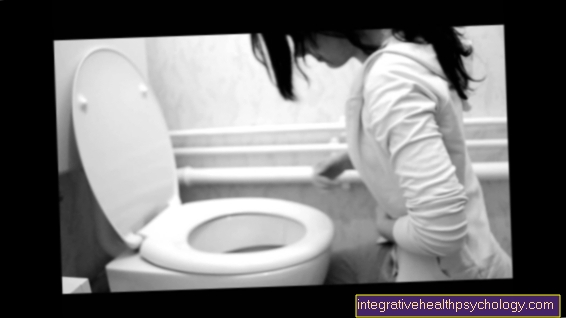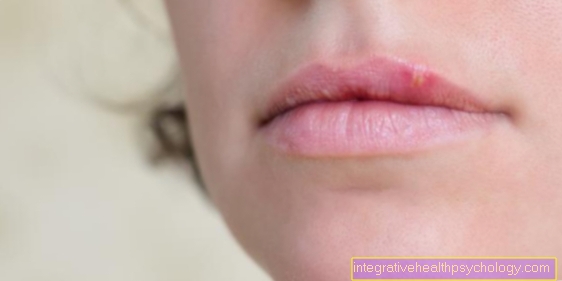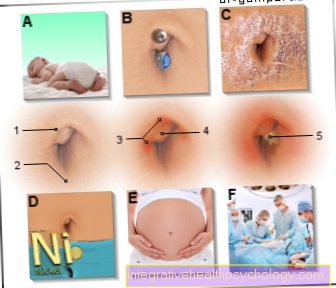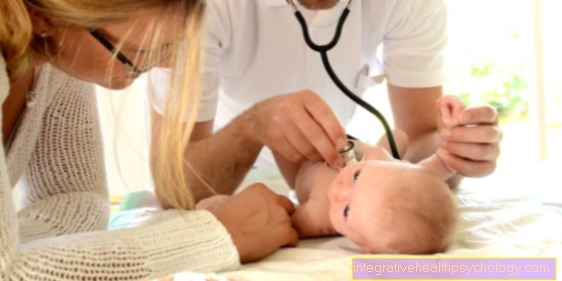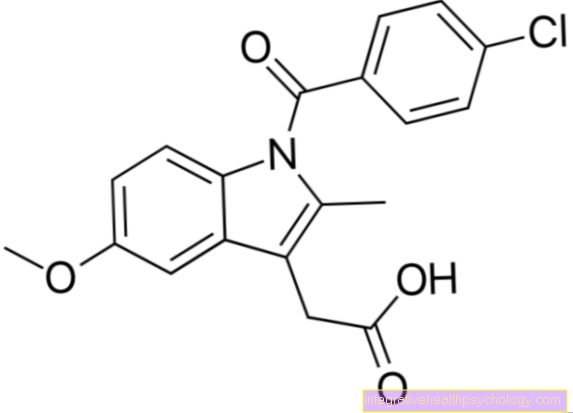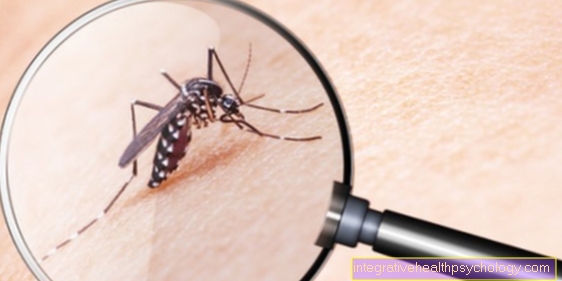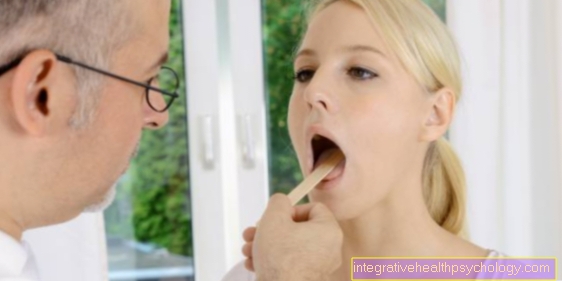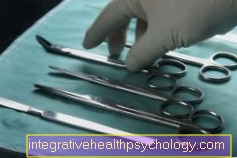Puncture
definition
A puncture is a generic term for a variety of medical interventions. Usually, a thin hollow needle or a corresponding instrument is used to pierce an organ, a body cavity or a blood vessel and either tissue or fluid is removed.

A puncture can be used for diagnostics, for example a kidney puncture to determine a possible kidney disease. On the other hand, a puncture can also be used primarily as a therapeutic measure, such as relieving a pathological accumulation of fluid in a body cavity (for example in the abdomen or in the pericardium).
Depending on the organ or area of the body on which the puncture is performed, there are risks of complications due to an injury. Therefore, before a puncture, the possible benefit must always be weighed against the risks.
More information on this topic at: Water in the pericardium and water in the abdomen
Indications for a puncture
Since the term puncture describes a large number of different medical interventions, the indications are diverse and spread across all specialist areas. The most frequently performed puncture is the collection of blood through a vein, for example at the family doctor or in the hospital to determine the blood values. In addition, in the case of an encapsulated purulent inflammation (abscess) under the skin or in an organ, a puncture is often indicated to drain the pus.
If conspicuous structures are detected in imaging diagnostics such as X-rays or computer tomography, a puncture of the respective structure may be useful.
In the case of a blood disease such as an unexplained anemia, a puncture and sampling of the bone marrow may be necessary.
Further indications exist when fluid accumulates in body cavities such as in the pleura (pleural effusion) or in the abdomen (ascites).
The puncture can on the one hand serve to relieve pressure and on the other hand provide diagnostic information about the cause of the water accumulation. In some cases, a puncture is also indicated if there is an effusion in a large joint.
In neurology, the cerebral fluid is punctured via the spinal canal if there is a suspicion that, for example, meningitis may be present.
Further information on this topic can be found at: water in the lungs
How does the doctor prepare the puncture?
Whether preparation is necessary in advance of a puncture depends on the type of procedure. In general, a hygienic procedure to prevent infection is indicated. Therefore, the puncture area must be disinfected beforehand. Depending on the target location of the puncture, a special position may be necessary (for example, sitting and bent over for a cerebral puncture).
The doctor performing the procedure will instruct the patient accordingly. In some cases, a topical anesthetic is injected under the skin before the actual puncture. Before puncturing organs such as the liver, the blood coagulation values must be checked beforehand.
How does a puncture work?
The general sequence of a puncture is that after the patient has been positioned in a certain position if necessary, the puncture site is disinfected.
Depending on the type of puncture, the skin area is then numbed with a syringe. During the procedure, it is important that the patient keep as still as possible and follow the doctor's instructions. If the liver or kidney is punctured, for example, special breathing maneuvers may be necessary.
If deeper organs or areas are punctured, this may be done under visual control using ultrasound or computed tomography. The patient receives further detailed information regarding the specific procedure of a puncture from the doctor who will perform it.
The evaluation of the intervention
The evaluation of a puncture depends primarily on which structure was punctured and with what aim.
In the case of a therapeutic puncture, i.e. if, for example, pus or accumulations of fluid are drained, the result is often evident immediately after the procedure. An example would be a patient who complains of shortness of breath due to water in the lungs. After a successful puncture of the effusion, breathing is usually immediately relieved.
In the case of a puncture that was performed for diagnostic purposes, the tissue or fluid removed is evaluated. Depending on the question, this can be done in a laboratory, a microbiological or a pathological institute, for example. As soon as the samples have been evaluated, the attending physician will be informed, who will classify them together with the other patient findings and develop the further procedure.
Risks of the procedure
The general risks with any type of puncture include bleeding, infection, and damage to organs, nerves, or blood vessels. In addition, severe pain can occur at the puncture site. These risks vary depending on where the puncture is performed. With a superficial puncture, such as taking blood from a vein on the arm, the risks are very low.
If, on the other hand, a deeper-lying organ such as the spleen or a kidney has to be punctured, the risk of damaging structures on the puncture path increases in particular. When puncturing malignant cells, there is also the risk that they will be carried over. The procedure can also spread the pathogens to inflamed areas. Other special risks are, for example, an injury to the lung cavity during a lung puncture, which can lead to a collapse of the lung, which usually requires treatment.
Before the puncture, the attending physician will explain all possible risks to the patient and answer any questions.
More information on the topic Pain after a puncture you'll find here.
Duration of a puncture
How long a puncture takes depends on how complex it is and how easy it is to reach the puncture site. A normal blood draw only takes a few minutes. An organ puncture of the lungs or the spleen, for example, is more complex and therefore takes longer. In the case of such punctures, a detailed explanation takes place in advance, during which the patient is also informed of the expected duration. Factors such as difficult anatomical conditions can significantly increase the time required.
costs
The range for the costs of a puncture is very large due to the many differences in the extent and complexity of the procedure. A puncture is usually only performed if there is a medical justification and is then usually fully covered by the health insurance company.
An exception are blood samples, which are carried out to determine laboratory values at the request of the patient. In this case the patient has to bear the costs himself. How high these are mainly depends on which values are to be determined. The patient can find out about the respective costs from the doctor in advance.
Special punctures
Puncture of the knee joint
A puncture of the knee joint may be indicated for two different reasons. On the one hand, to drain a possible joint effusion and examine it if necessary. Whether this is clear, purulent or rather bloody can provide important information about the cause and thus enable targeted treatment.
The pressure relief can directly relieve pain. On the other hand, a puncture of the knee can also be used to inject a specific drug into the joint, which can be an option for treating pain, for example.
In any case, the potential benefits of puncturing the knee joint should outweigh the risks. Any puncture in a joint can lead to injury and infection, which makes the patient's condition worse.
Read more on this topic at: Puncture of the knee joint
Intracytoplasmic Sperm Injection (ICSI)
A very special type of puncture is necessary for intracytoplasmic sperm injection (ICSI) as part of artificial insemination.
Before the puncture is performed, the woman is given hormone treatment that stimulates the growth of several follicles in the ovary. After about 10 to 12 days, another hormone triggers ovulation. The actual puncture is then carried out two days after this hormone has been administered. In this case, it is egg retrieval through a long needle. This is advanced through the vagina under ultrasound control. The procedure is usually performed under a short anesthetic and takes about 10 to 15 minutes.
The man's semen must be released on the same day. A single sperm is then inserted into each of the extracted egg cells in the laboratory. If fertilization is successful, the cells divide in the following days in the incubator up to the vesical stage. Then often two of these early embryos are inserted into the uterus. In about 25 to 30% of cases, the ICSI results in a pregnancy.
Puncture of the lungs
It is possible to puncture the lungs and thereby take tissue samples. This comes into question, for example, if a conspicuous structure has been discovered in imaging (for example computed tomography) and you want to examine it more closely.
Depending on the position of the puncture target, the procedure can be performed either from the outside through the chest wall or from the inside through the airways. In the latter, the puncture is performed as part of a lung specimen (bronchoscopy).
More often, however, it is not the lungs that are punctured directly but the gap between the pleura and the pleura, which is called the pleural space. There is usually only a very small amount of liquid in this. Various diseases can lead to an effusion and thus to an accumulation of fluid in the pleural space, which can even lead to impaired breathing. The effusion can be drained through the pleural puncture and, if necessary, a sample can be examined to find out the cause of the water retention.
With both direct lung puncture and pleural puncture, air can penetrate the pleural space. As a result, the punctured lung can collapse. One speaks of a pneumothorax, which has to be treated as an inpatient in the hospital.
More on this topic at: Pleural puncture
Puncture of the breast tissue
A puncture of the breast is usually done when an abnormal structure (such as a lump) is to be examined. This can be noticed, for example, in the context of breast cancer screening. The puncture is usually intended to clarify whether the structure is benign or malignant.
In most cases, the breast puncture is performed using fine needle aspiration. Tissue and cells are removed from the breast with a special, very thin hollow needle. The examination is usually no more painful than taking a blood sample. Local anesthesia is therefore usually not necessary. The results are often available on the same day.
An alternative is the punch biopsy, in which a small tissue bridge is removed from the breast with a slightly larger needle.
Further information on this topic can be found at: biopsy
Puncture of the hip joint
Puncturing the hip joint may be considered if there is an effusion in the joint.
On the one hand, joint puncture can lower the pressure in the hip and thus alleviate pain. On the other hand, the removed liquid can be examined for the presence of bacteria, for example.
In addition, a hip joint puncture can also be used for the local application of medication, for example to treat pain.
Puncture of the abdomen
A puncture on the abdomen is performed if there is a pathological accumulation of fluid in the abdominal cavity. This is also known as ascites or ascites.
This can occur, for example, in severe liver dysfunction, for example as a result of inflammation of the liver (hepatitis) or excessive alcohol consumption. Abdominal cancers can also lead to ascites. Depending on the extent, the amount of liquid can be a few liters and lead to restricted mobility and shortness of breath. The ascites puncture serves on the one hand for direct relief by draining part of the fluid from the abdomen. On the other hand, a sample can be examined in order to obtain information about the cause of ascites.
In order to avoid injuring organs such as the intestine or liver as much as possible, the puncture can be performed under visual control using ultrasound.
Read more on the subject at: Puncture water in the abdomen
Puncture of the liver
A liver puncture is used to remove tissue (biopsy) to examine diffuse or circumscribed liver changes. The puncture is primarily used to confirm the diagnosis if a suspected diagnosis could already be made based on the patient's blood values and symptoms.
The puncture is performed ultrasonically through the skin. Compared to other abdominal organs, the liver can be reached relatively easily with the puncture needle. Nevertheless, abdominal organs or the lungs can be injured.
By taking samples, the tissue can be examined for inflammatory or malignant changes, for example.
Among other things, the presence of a liver sponge (liver hemangioma), jaundice due to an obstacle to drainage of the biliary tract or a severe blood clotting disorder speak against a puncture.
Puncture of the cerebral water (lumbar puncture)
A cerebral fluid puncture or CSF puncture is necessary, for example, if there is a suspicion that an inflammatory disease of the central nervous system could be present.
In most cases, the puncture is performed in the lumbar spine area. One then speaks of a lumbar puncture. The patient sits for the procedure and bends the upper body forward as far as possible. Alternatively, the puncture can also be performed while lying down.
The doctor uses a long, thin needle to insert between two vertebral bodies into the spinal canal. A sample of the brain water can then be taken there. In the area of the lumbar spine there are only nerve fibers but no spinal cord, so that it cannot be injured. However, if the needle touches a nerve fiber, there may be brief paresthesia in the legs.
In addition to the diagnostic use, the puncture of cerebral fluid is also used for an overproduction of liquor. The procedure can alleviate possible symptoms such as headaches and gait problems.
Much more information under our topic: Lumbar puncture




